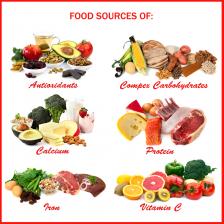How Much Fat Should You Eat?
Low-fat diets have (thankfully) fallen out of fashion. But how much fat is too much? Nutrition Diva investigates

Katrina writes:
“I have always considered myself a healthy eater but you have helped me focus on some areas which were lacking in my diet. In particular, I am now regularly getting your a day. I started tracking my calorie intake a while back and I noticed that fat makes up an average of 30-35% of my daily calories but sometimes edges as high as 40%. I know that the recommended daily allowance is 20-35% which places me at the high end of the spectrum, even on a good day. My diet is high in healthy fats including , , and and I do not eat a lot of . It is also a bit higher in protein and lower in carbohydrates since I avoid , white flour, and except on . However, I am wondering if my fat intake might be a problem.”
From what Katrina has outlined here, I think her diet is healthier than most! If anything, she’s a little ahead of the curve.
Sponsor: The podcast version of this article is brought to you by Stitcher. With free https://www.stitcher.com/diva, you can listen to this and thousands of other podcasts on your mobile phone. Use promo code DIVAand get a chance to win a cash prize.
The field of nutrition has been gradually recovering from the misguided fat-phobia that—among other things—influenced the Institutes of Medicine’s recommendation that fat take up no more than 35% of your calories. In fact, in a recent email exchange with me, Walter Willett from the Harvard University School of Public Health suggested that getting up to 40% of one’s calories from healthy sources of fat would be perfectly acceptable—especially if those calories /health-fitness/healthy-eating/do-low-carb-diets-work
I’ve talked about the IOM’s recommendations before, in the context of similar discussion about /health-fitness/healthy-eating/how-much-protein-should-you-eat. The guidelines allow for anywhere from 10% to 35% of calories as protein, which is a very broad range. For someone my size, 10% of calories would be a little over 50 grams of protein and 35% would be almost 200 grams! How can both be equally good for me?
The lower end of the range represents the minimum amount of protein your body needs to function. And although you don’t necessarily need more protein than that, I’ve discussed various /health-fitness/healthy-eating/how-much-protein-should-you-eat in previous episodes. But keep in mind that the IOM isn’t just looking at the effects of protein (or fat) in a vacuum. They’re also trying to consider how higher or lower intakes of one nutrient might affect the balance of other nutrients in the diet.
It’s a Zero Sum Game
Remember that the percentage of protein, fats, and carbohydrates always has to add up to 100%. If you decrease the percentage of one, the percentage of another will have to increase. Previous efforts on the part of the government and public health agencies to get us to avoid fat, for example, led to a dramatic increase in the amount of carbohydrates in the typical diet. With the benefit of hindsight, we can now see excessive carbohydrates (especially refined carbohydrates) are doing much more damage to our health than the fat they replaced.
The obvious corollary to Willett’s suggestion that the IOM’s recommended range for fat might be too low is that the recommended range for carbohydrates could be too high—at least for the type of carbs that we seem to prefer.
You Can Have Too Much of a Good Thing
Of course, simply eating more fat doesn’t guarantee that your diet will be healthier. You want to be sure that you’re choosing healthy sources of fats, which it sounds like Katrina is. And even though nuts and avocados are chock full of healthy fats, you can consume a lot of calories in just a few bites. Too many calories—even from healthy foods—can translate into unwanted weight gain. Fortunately, it sounds like Katrina is also keeping an eye on her total calorie intake.
Check out: /health-fitness/healthy-eating/can-you-lose-weight-without-counting-calories
And finally, you want to be sure that your diet is otherwise balanced and nutritious, limiting empty calories and including lots of fruits and vegetables and good sources of protein. Again: Bravo, Katrina!
A Healthy Diet is More Than Just a Number
And now I hope you understand why I reproduced Katrina’s email in its entirety. If Katrina’s question had simply been “Is 40% of calories from fat too much?” I wouldn’t have known how to answer her. It’s like trying to decide whether you like a symphony having heard only the timpani part.
There are a lot of ways to put together a healthy diet. Your diet might be lower in protein or higher in fat than mine. But single numbers like how many grams of protein or fat you eat in a day don’t tell the whole story. It’s all about the big picture. And based on her email, it sounds like Katrina is definitely on the right track. Keep up the good work!
Keep in Touch
Thanks again to Katrina for her email. I’ll be sending her a signed copy of my book,. It’s available wherever you buy or download books.
If you are a new or recent college grad, or know someone who is, be sure to pick up a copy of our latest ebook, . It’s jam-packed with tips on every aspect of your new life, from me and the other Quick and Dirty Tips experts.
Post your comments and questions below or come join the discussion on the Nutrition https://facebook.com/nutritiondiva page. I always love to hear from you! I answer a lot of listener questions in my free weekly newsletter, so if you’ve sent a question my way, be sure you’re /static/ndnewsletter.html.
Have a great week and remember to eat something good for me.
Image courtesy of Shutterstock


